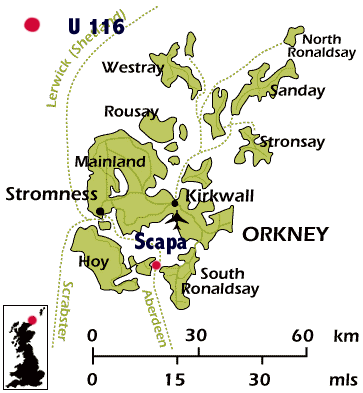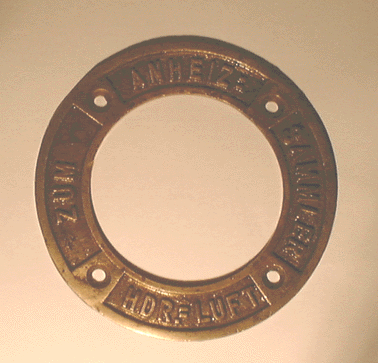![]()


![]()
|
|||||||||||||||||||||||||||||||||||||||||||||||||||||||||||||||||||||||||||||||||||||||||||||||||||||||||
![]()
The loss of the U116 on 28th October 1918
On 21st October 1918, when Germany had asked for an armistice, Admiral Reinhard Scheer, the victor of the Battle of Jutland and now Commanding Admiral of the High Seas Fleet, called off the unrestricted U-boat campaign in 1918: "To all U-boats: Commence return from patrol at once. Because of ongoing negotiations any hostile actions against merchant vessels prohibited. Returning U-boats are allowed to attack warships only in daylight. End of message. Admiral" However, the U-boat war ended as it had begun in 1914 - with a bold move...... 
![]()
UB-116 was a new U-boat with a new skipper, Oblt.z.S. Emsmann, who had already commanded U-boats UB-5, UB-10 and UB-40. On ten previous patrols he had sunk 27 ships with a total displacement of 9,221 tons. On this mission to Scapa Flow, unusually, he had a volunteer crew of 34 officers. The boat was fully laden with with 10 torpedoes and he was commanded to sail for Hoxa Sound with detailed navigation instructions issued on the 23rd October. This was a dangerous mission to the Orkneys, located off the north coast of Scotland, home to the Grand Fleet of the Royal Navy.
When he sailed, on the evening of the 25th October, Emsmann told a colleague ashore that he knew he would not return.
After a three day passage from Wilhelmshaven Germany, finally picking his path through the treacherous currents of the Pentland Skerries, Muckle Skerry and Lothar Reef, he headed for Hoxa Sound between South Ronaldsay and Flotta. He passed the first line of defences and entered Scapa Flow and Hoxa Sound, home of the Grand Fleet.
The British fleet was protected by the natural harbour, blockships, observers and inner and outer minefields, with electrical indicators. The controlled inner minefield consisted of lines of mines, each surrounded by an electrical indicating loop. When an observer noticed the tell-tale needle of a loop deflected and saw that there was no surface ship in the vicinity, he pressed the button and a line of mines exploded. The Royal Navy had fortuitously installed these antisubmarine measures in December 1914, not long after the declaration of war with Germany.
On 28th October 1918, German U-Boat UB-116 commanded by Oberleutnant Hans Joachim Emsmann, was spotted by shore lookouts on the surface outside the entrance to Hoxa Sound, when he briefly surfaced and was later detected by hydrophones and sunk by mines, with the loss of all hands in the vicinity of Hoxa Sound off Flotta.
![]()

A British Admiralty diver Dusty Miller, was told to dive on a submarine recently sunk in the northern mine barrage "off the Orkneys". The weather was bad and "...the electric instrument for locating metal at the bottom of the sea gave no result for some unaccountable reason..." This was a reference to the new Anglo-French invention of echo-sounding called ASDIC, first used in 1917.
However, two trawlers working together made figure-of-eight sweeps for the whole of the next day until they caught wires on the submarine. Dusty Miller went down and had to undertake a controlled explosion on the conning-tower hatch and then went inside. It was pitch black and his torch lit only a few feet ahead of him. All the crew were in officers' uniforms and near the control room, he found a stack of "...neat leather suitcases..." He prised open several of them and was surprised to find that all the contents were the same. "...a couple of suits of smart civilian clothes, shirts, collars, cravats and shoes, together with sums of money and other things..."
Dusty Miller said little more about this and his Admiralty masters were just as secretive and puzzled as he was. Was it the intention of the mysterious crew to land somewhere in neutral Spain once they had completed their mission, and that the civilian clothes were for a return overland to Germany?
The Admiralty and German archives of the time do not mention the incident. Captain Damant's log (an Admiralty diver) says that the boat's log and the leather cases cases were recovered, but were taken away by the local Naval authorities. He made no mention of an all-officer crew, but named the U-boat with the suitcases as UB-116.
When nothing was heard from UB-116, the German command assumed that she had been caught and destroyed trying to break into Scapa Flow, As had happened with UB-18 and UB-15. This confirmed that the anchorage was indeed impregnable. All further plans to attack the Grand Fleet's home base were now abandoned and the war ended a few days later.
But the two brave but fruitless attacks on the main British fleet base ( UB-18 and UB-116) were not forgotten in Germany. However, it was not until 21 years later that Gunther Prien succeeded in sinking a battleship in Scapa Flow, where UB-18 and UB-116 had failed.Today, the boat lies in about 28 metres of water, but there is now little left of the wreck of UB-116 off Hoxa, at the entrance to Pan Hope Bay. She was sold for salvage in 1969 and later the Royal Navy made safe the 10 live torpedoes by a controlled explosion. Sections of plating, together with pipes, wires and broken switch-boxes are all that remain on the seabed and the only really identifiable parts are the ballast tanks and a deck gun. These are unlikely to be much help in solving the mystery of UB-116. The last U-boat to be sunk in the First War.
![]()

Bronze airvalve indicator ring from U116 following controlled explosions in 1970.
![]()
![]()
Special thanks for detailed information to Dr John Bullen BA MA PhD - Imperial War Museum London UK. Any errors are mine sc/29/04/2002